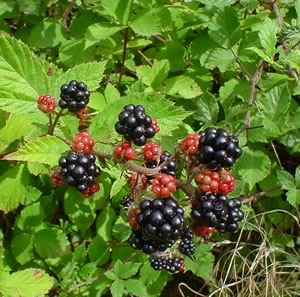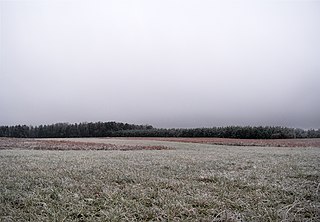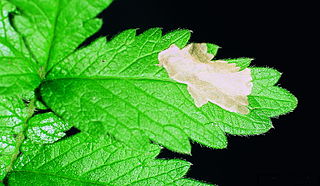
Rubus is a large and diverse genus of flowering plants in the rose family, Rosaceae, subfamily Rosoideae, with over 1,350 species.

Cirrostratus is a high-level, very thin, generally uniform stratiform genus-type of cloud. It is made out of ice-crystals, which are pieces of frozen water. It is difficult to detect and it can make halos. These are made when the cloud takes the form of thin cirrostratus nebulosus. The cloud has a fibrous texture with no halos if it is thicker cirrostratus fibratus. On the approach of a frontal system, the cirrostratus often begins as nebulous and turns to fibratus. If the cirrostratus begins as fragmented of clouds in the sky it often means the front is weak. Cirrostratus is usually located above 5.5 km (18,000 ft). Its presence indicates a large amount of moisture in the upper troposphere. Clouds resembling cirrostratus occasionally form in polar regions of the lower stratosphere. Polar stratospheric clouds can take on this appearance when composed of tiny supercooled droplets of water or nitric acid.

Stratus clouds are low-level clouds characterized by horizontal layering with a uniform base, as opposed to convective or cumuliform clouds that are formed by rising thermals. More specifically, the term stratus is used to describe flat, hazy, featureless clouds at low altitudes varying in color from dark gray to nearly white. The word stratus comes from the Latin prefix strato-, meaning "layer". Stratus clouds may produce a light drizzle or a small amount of snow. These clouds are essentially above-ground fog formed either through the lifting of morning fog or through cold air moving at low altitudes over a region. Some call these clouds "high fog" for their fog-like form. While light rain may fall, this cloud does not indicate much meteorological precipitation.

Rubus chamaemorus is a species of flowering plant in the rose family Rosaceae, native to cool temperate regions, alpine and arctic tundra and boreal forest. This herbaceous perennial produces amber-colored edible fruit similar to the blackberry. English common names include cloudberry, nordic berry, bakeapple, knotberry and knoutberry, aqpik or low-bush salmonberry, and averin or evron.

The raspberry is the edible fruit of a multitude of plant species in the genus Rubus of the rose family, most of which are in the subgenus Idaeobatus. The name also applies to these plants themselves. Raspberries are perennial with woody stems. World production of raspberries in 2020 was 895,771 tonnes, led by Russia with 20% of the total.

Rubus idaeus is a red-fruited species of Rubus native to Europe and northern Asia and commonly cultivated in other temperate regions.

Rubus occidentalis is a species of Rubus native to eastern North America. Its common name black raspberry is shared with other closely related species. Other names occasionally used include bear's eye blackberry, black cap, black cap raspberry, and scotch cap.

The brown bullhead is a fish of the family Ictaluridae that is widely distributed in North America. It is a species of bullhead catfish and is similar to the black bullhead and yellow bullhead. It was originally described as Pimelodus nebulosus by Charles Alexandre Lesueur in 1819, and is also referred to as Ictalurus nebulosus.

The China rockfish, the yellowstripe rockfish or yellowspotted rockfish, is a species of marine ray-finned fish belonging to the subfamily Sebastinae, the rockfishes, part of the family Scorpaenidae. It is native to the waters of the Pacific Ocean off western North America.

Rubus armeniacus, the Himalayan blackberry or Armenian blackberry, is a species of Rubus in the blackberry group Rubus subgenus Rubus series Discolores Focke. It is native to Armenia and Northern Iran, and widely naturalised elsewhere. Both its scientific name and origin have been the subject of much confusion, with much of the literature referring to it as either Rubus procerus or Rubus discolor, and often mistakenly citing its origin as western European. Flora of North America, published in 2014, considers the taxonomy unsettled, and tentatively uses the older name Rubus bifrons.

The Algerian ribbed newt is a species of salamander in the family Salamandridae found in Algeria and Tunisia. The natural habitats of this newt are rivers, intermittent rivers, swamps, cisterns, freshwater marshes, intermittent freshwater marshes, and ponds. It is threatened by habitat destruction.
Hemicordylus nebulosus is a species of lizard in the Cordylidae family. It is endemic to South Africa on the mist belt of northern slope of the hotten-totshooland mountains. The scientific name, H. Nebulosus means cloud or dark crag lizard. The name was given due to the melanistic body color. Other names include the dawrf cliff lizard, dawrf crag lizard, dark crag lizard and the cloudy crag lizard.

Cirrostratus nebulosus is a type of high-level cirrostratus cloud. The name cirrostratus nebulosus is derived from Latin, the adjective nebulosus meaning "full of vapor, foggy, cloudy, dark". Cirrostratus nebulosus is one of the two most common forms that cirrostratus often takes, with the other being cirrostratus fibratus. The nebulosus species is featureless and uniform, while the fibratus species has a fibrous appearance. Cirrostratus nebulosus are formed by gently rising air. The cloud is often hard to see unless the sun shines through it at the correct angle, forming a halo. While usually very light, the cloud may also be very dense, and the exact appearance of the cloud can vary from one formation to another. In the winter, precipitation often follows behind these clouds; however, they are not a precipitation-producing cloud.

Coptotriche marginea is a moth of the family Tischeriidae. It is found in most of Europe.

Rubus argutus is a North American species of prickly bramble in the rose family. It is a perennial native to the eastern and south-central United States from Florida to Texas, Missouri, Illinois, and Maine. Common names are sawtooth blackberry or tall blackberry because of its habit of growing up to 2 meters in height.

Coptotriche heinemanni is a moth of the family Tischeriidae. It is found in most of Europe, except the Iberian Peninsula and the Balkan Peninsula.

Rubus fruticosus L. is the ambiguous name of a European blackberry species in the genus Rubus in the rose family. The name has been interpreted in several ways:
The New Caledonian long-eared bat, species Nyctophilus nebulosus, is a vespertilionid bat found in New Caledonia. They are only recorded at Mount Koghis, near Nouméa, and the population is decreasing.

Diastrophus is a genus of gall wasps in the family Cynipidae. There are at least eight described species in Diastrophus.

Stratus nebulosus is a species of low-level stratus cloud. It is one of only two species that is associated with stratus clouds, other being fractus. Translated from Latin meaning nebulous, their cloud abbreviations can be respectively written as ‘St neb’. For a cloud to be classified as nebulosus, there has to be zero sign of detail in the cloud.
















